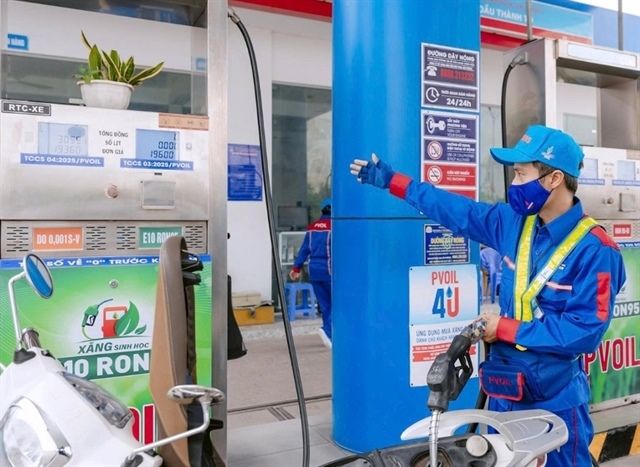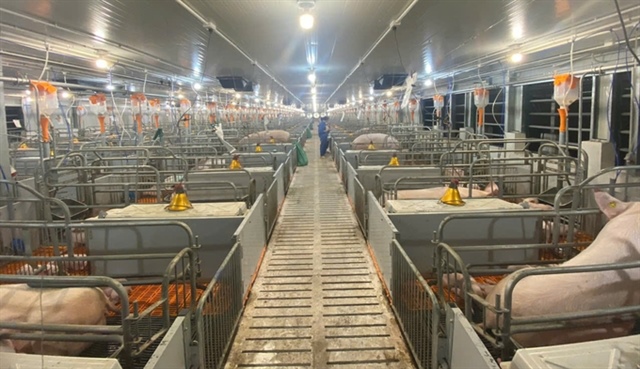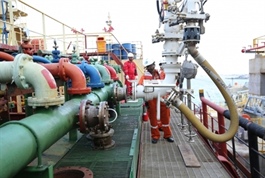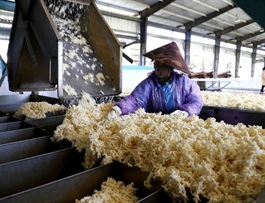Cement companies suffer losses, pressured by lower consumption and rising prices
Cement companies suffer losses, pressured by lower consumption and rising prices
Difficulties in production and consumption are still facing cement businesses. Input prices for cement production continued to increase, also putting a burden on enterprises.
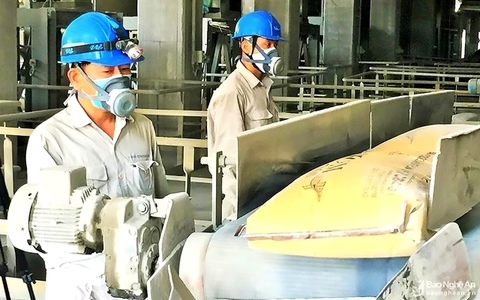
A production line of Vicem Hoàng Mai Cement Joint Stock Company. In the first six months of 2023, Vicem Hoàng Mai recorded VNĐ808 billion in sales revenue and VNĐ622 million in profit after tax, down 22.8 per cent and 94.6 per cent respectively over the same period last year. — Photo ximanghoangmai.vn |
Since the beginning of this year, cement production and consumption have faced many difficulties. Given the slow domestic consumption, many cement enterprises have chosen to export as a temporary solution to deal with excessive cement sources. However, Việt Nam's cement export markets also faced hardships. Many cement enterprises continuously suffered losses throughout the quarters.
Occupying about 36 per cent market share, Việt Nam Cement Corporation (VICEM) has also suffered. General Director of VICEM Lê Nam Khánh said that the first quarter of 2023 saw the lowest consumption amount in the more than 120-year history of Việt Nam's cement industry.
Đinh Quang Dũng, Deputy General Director of VICEM, said that input prices for cement production continued to increase when electricity prices rose by 3 per cent, coal prices remained high, so production and business efficiency were greatly affected.
This made the company fail to achieve the business goals set out and had to deal with a large inventory, both cement and clinker. Since the end of 2022, a number of cement plants in the VICEM system had to reduce capacity and stop production, Dũng said.
Currently, the design capacity of cement plants is up to 120 million tonnes per year, while the demand for cement is only about 65 million tonnes. The amount of clinker in inventory is very large, which must be dumped out into the environment, which not only increases production costs but also pollutes the environment, Dũng said.
The financial statements of the past 2 quarters of many member units in the VICEM system have continuously recorded losses. Typically, Vicem Hoàng Mai Cement Joint Stock Company reported that its revenue in the second quarter of 2023 decreased by nearly half compared to the same period last year, to VNĐ358 billion. The reason was due to the decline in consumption volume, so the enterprise had to reduce production to avoid inventory.
Cement production in the second quarter of 2023 of Vicem Hoàng Mai was 313,000 tonnes, down by 168,000 tonnes over the same period last year, and clinker output decreased by 162,000 tonnes.
In the first six months of 2023, Vicem Hoàng Mai recorded VNĐ808 billion in sales revenue and VNĐ622 million in profit after tax, down 22.8 per cent and 94.6 per cent respectively over the same period last year.
Bỉm Sơn Vicem Cement Joint Stock Company also reported a loss of more than VNĐ5 billion in the second quarter of the past year due to decreased sales and increased financial expenses. According to the consolidated financial statements of the second quarter, all of Vicem Bỉm Sơn's revenue comes from cement and clinker with nearly VNĐ893 billion, down 21 per cent over the same period last year. Notably, this was the fourth consecutive quarter of its reporting losses (since the third quarter of 2022).
According to the explanation of Bỉm Sơn Vicem Company, the increase in financial expenses was greater than the decrease in the cost of goods sold, selling expenses, business administration expenses, and other expenses, leading to a decrease in profit after tax.
Accumulated in the first 2 quarters of this year, this business achieved nearly VNĐ1.7 trillion in net revenue, down 25 per cent. However, the net loss was more than VNĐ52 billion, while in the same period last year, the profit was VNĐ130 billion.
Bỉm Sơn Vicem Cement Joint Stock Company plans to achieve total revenue of nearly VNĐ4.63 trillion in 2023, up 10 per cent; and more than VNĐ40 billion in profit after tax, down 56 per cent compared to 2022.
Another member of VICEM, Vicem Bút Sơn Cement Joint Stock Company, also reported a net loss of more than VNĐ17 billion in the second quarter; while, in the same period last year, this business made a profit of VNĐ30 billion. This is also the third consecutive quarter that Vicem Bút Sơn has fallen into a state of loss, since the fourth quarter of 2022.
In six months, Vicem Bút Sơn achieved more than VNĐ1.34 trillion in net revenue, down 12 per cent; net loss was over VNĐ32 billion, while in the same period last year its profit was VNĐ47 billion.
In 2023, Vicem Bút Sơn set a total revenue of more than VNĐ3.53 trillion, up 12 per cent compared to 2022. Profit after tax is forecast at more than VNĐ32 billion, down 40 per cent.
According to Lương Đức Long, General Secretary of the Vietnam Cement Association, the cost of coal accounts for 45-55 per cent of the production cost of 1 tonne of clinker, the cost of electricity accounts for 17 - 20 per cent of the cost of a tonne of cement. The increase in energy prices leads to an increase in transportation costs.
Meanwhile, export market demand decreased, clinker export tax increased from 5 per cent to 10 per cent starting January 1, 2023, Long said.
Facing the situation of slow domestic consumption, many cement enterprises have chosen to export as a temporary solution to deal with excessive cement sources. However, from the beginning of this year, Việt Nam's cement export market has still faced hardship, he said.


